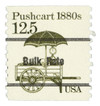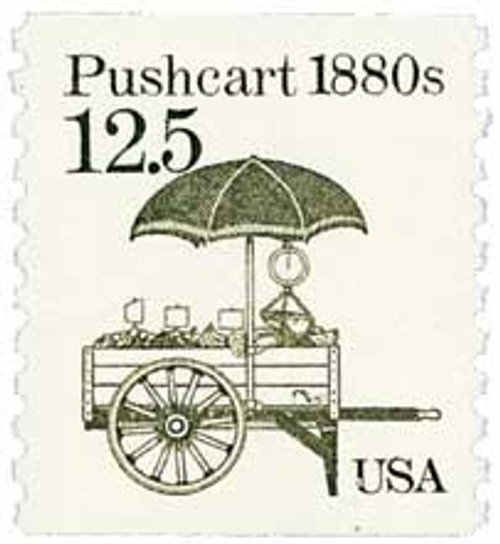
# 2133a - 1987 12.5c Pushcart, precancel, coil
U.S. #2133a
1985 12.5¢ Pushcart, 1880s, Precanceled
Transportation Series
- Paid the rate on bulk third-class mail sorted to three-digit ZIP codes
- Stamp image based on a vintage NYC fruit cart
Stamp Category: Definitive
Series: Transportation
Value: 12.5¢; the rate for bulk third-class mail sorted to three-digit ZIP code
First Day of Issue: April 18, 1985
First Day City: Oil Center, New Mexico
Quantity Issued: 345,692,000
Printed by: Bureau of Engraving and Printing
Printing Method: Engraved
Format: Coils of 500 and 3,000
Perforations: 10 Vertical
Color: Olive green
Why the stamp was issued: For use on bulk rate third-class mail sorted to three-digit ZIP codes.
About the stamp design: Jim Schleyer based his pen and ink illustration for this stamp on a fresh fruit cart he’d seen in Brooklyn.
Special design details: The 12.5¢ Pushcart stamp was available with and without a precancel. #2133 has no precancel, while #2133a has a precancel. Precancels are stamps canceled before being sold, to make mailing faster and cheaper for customers with large amounts of mail. Bulk mailers use precancels, then pre-sort their mail and save money. The USPS makes these stamps available with and without precancels for two reasons. One reason is to create another variety for stamp collectors. The other, is so the stamps can be used as add-on postage for packages slightly overweight.
Unusual fact about this stamp: Imperforate errors of this stamp exist.
About the Transportation Series: On May 18, 1981, the USPS issued the first stamp in the Transportation Series, US #1907, picturing the Surrey, a doorless four-wheeled carriage. For the first time in US history, a coil stamp featured its own unique design rather than simply copying that of the current definitive stamp. Over 50 more coil stamps would be issued over the course of the next 15 years, each picturing a different mode of transportation. All of these types of transportation were used since American independence.
The various denominations provided face values to exactly match the rates for several categories of Third-Class mail (bulk rate and quantity-discounted mail). As the rates changed, new stamps with new values were added. Never before had a stamp series included so many fractional cent values.
The Bureau of Engraving and Printing printed most of the stamps in the Transportation Series, although private contractors printed a few. All but a few of the later stamps were produced by engraved intaglio. Differences in precancels, tagging, paper and gum provide a large number of varieties.
Scott Catalog separates the Transportation stamps into four groups. The stamps in the first group (#1897-1908) generally have the denomination in small type with a “c” next to it. These stamps were printed on the Cottrell rotary press, which joined together two plates to make a sleeve. The gaps between these plates created depressions where ink would collect and create joint lines on the stamps. Later issues were printed on a different press and didn’t have these joint lines.
The second group (#2123-36) had larger numbers with no “c.” The third group (#2252-66) was similar in appearance to the second group, but service inscriptions were added to the designs. These stamps also used a variety of paper and gum as well as different types of tagging. The fourth group (#2451-68) marked the end of fractional values. Now bulk mailers would use either the 5¢ or 10¢ stamp and then pay the difference from the actual postage rate.
The last stamp in the Transportation Series, the 20¢ Cog Railway, was issued on June 9, 1995, at the TEXPEX ’95 stamp show in Dallas, Texas. This marked the end of the largest US definitive series up to that time and the largest US coil stamp series in history. Three new series would eventually replace it – American Transportation, American Culture, and American Scenes. Additionally, the Great Americans would go on to become the largest American definitive series.
History the stamp represents: Although the two-wheeled pushcart dates back thousands of years before the four-wheeled wagon was invented, the one pictured on this stamp was typically used in the early 20th century. These small stores on wheels sold everything from groceries and produce to clothing and hardware. Today, they are less frequently seen, but can still be found on city streets vending food and drink.
U.S. #2133a
1985 12.5¢ Pushcart, 1880s, Precanceled
Transportation Series
- Paid the rate on bulk third-class mail sorted to three-digit ZIP codes
- Stamp image based on a vintage NYC fruit cart
Stamp Category: Definitive
Series: Transportation
Value: 12.5¢; the rate for bulk third-class mail sorted to three-digit ZIP code
First Day of Issue: April 18, 1985
First Day City: Oil Center, New Mexico
Quantity Issued: 345,692,000
Printed by: Bureau of Engraving and Printing
Printing Method: Engraved
Format: Coils of 500 and 3,000
Perforations: 10 Vertical
Color: Olive green
Why the stamp was issued: For use on bulk rate third-class mail sorted to three-digit ZIP codes.
About the stamp design: Jim Schleyer based his pen and ink illustration for this stamp on a fresh fruit cart he’d seen in Brooklyn.
Special design details: The 12.5¢ Pushcart stamp was available with and without a precancel. #2133 has no precancel, while #2133a has a precancel. Precancels are stamps canceled before being sold, to make mailing faster and cheaper for customers with large amounts of mail. Bulk mailers use precancels, then pre-sort their mail and save money. The USPS makes these stamps available with and without precancels for two reasons. One reason is to create another variety for stamp collectors. The other, is so the stamps can be used as add-on postage for packages slightly overweight.
Unusual fact about this stamp: Imperforate errors of this stamp exist.
About the Transportation Series: On May 18, 1981, the USPS issued the first stamp in the Transportation Series, US #1907, picturing the Surrey, a doorless four-wheeled carriage. For the first time in US history, a coil stamp featured its own unique design rather than simply copying that of the current definitive stamp. Over 50 more coil stamps would be issued over the course of the next 15 years, each picturing a different mode of transportation. All of these types of transportation were used since American independence.
The various denominations provided face values to exactly match the rates for several categories of Third-Class mail (bulk rate and quantity-discounted mail). As the rates changed, new stamps with new values were added. Never before had a stamp series included so many fractional cent values.
The Bureau of Engraving and Printing printed most of the stamps in the Transportation Series, although private contractors printed a few. All but a few of the later stamps were produced by engraved intaglio. Differences in precancels, tagging, paper and gum provide a large number of varieties.
Scott Catalog separates the Transportation stamps into four groups. The stamps in the first group (#1897-1908) generally have the denomination in small type with a “c” next to it. These stamps were printed on the Cottrell rotary press, which joined together two plates to make a sleeve. The gaps between these plates created depressions where ink would collect and create joint lines on the stamps. Later issues were printed on a different press and didn’t have these joint lines.
The second group (#2123-36) had larger numbers with no “c.” The third group (#2252-66) was similar in appearance to the second group, but service inscriptions were added to the designs. These stamps also used a variety of paper and gum as well as different types of tagging. The fourth group (#2451-68) marked the end of fractional values. Now bulk mailers would use either the 5¢ or 10¢ stamp and then pay the difference from the actual postage rate.
The last stamp in the Transportation Series, the 20¢ Cog Railway, was issued on June 9, 1995, at the TEXPEX ’95 stamp show in Dallas, Texas. This marked the end of the largest US definitive series up to that time and the largest US coil stamp series in history. Three new series would eventually replace it – American Transportation, American Culture, and American Scenes. Additionally, the Great Americans would go on to become the largest American definitive series.
History the stamp represents: Although the two-wheeled pushcart dates back thousands of years before the four-wheeled wagon was invented, the one pictured on this stamp was typically used in the early 20th century. These small stores on wheels sold everything from groceries and produce to clothing and hardware. Today, they are less frequently seen, but can still be found on city streets vending food and drink.











